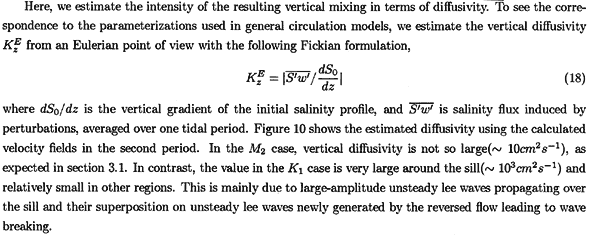Such higher-order modal waves generated at abrupt topographic changes are often observed around shelf breaks (e.g., Kuroda and Mitsudera 1995). These observations indicate that the processes described above and which were obtained by our numerical model are not artificial but common phenomena in real seas.
When propagating across the sill, this large-amplitude wave encounters an unsteady lee wave newly generated at the left-hand break by the leftward flow (after 0.75period). This is clearly seen in the distribution of vertical velocity (Fig. 6f), where the propagating lee wave(a 3rd-mode-like structure) locates on the right side of downwelling associated with the new unsteady lee wave. These lee waves are superposed and interact with each other (after 0.875period). This event produces a strong bottom intensified current over the sill top (shown in Fig. 7) and a large amplitude elevation at the foot of the unsteady lee waves (above the left-hand break in Fig. 5h).
Figure 8 shows the subsequent evolution of isopycnal displacements. As the flow turns to the right, the large-amplitude elevation at the foot of the lee wave gradually breaks (density inversion is apparent in Fig. 8a), propagating rightward, and causes intense vertical mixing over the sill top after 1.125periods. As this large-amplitude elevation passes over the right-hand break, it produces strong overflow accompanied) with a strong bottom intensified current, which may strengthen the excitation of unsteady lee wave around the right-hand break (after 1.25periods). For this superposition of a newly generated lee wave and that propagating rightward, their ray paths form a distinct V-shaped (Fig. 8c), as do internal tides. Note that unsteady lee waves can propagate toward only one side unlike internal tides which propagate both sides. The superposition of the unsteady lee waves forms a large amplitude elevation like a hydraulic jump, inducing intense vertical mixing (density inversion is apparent after 1.375periods). Again, an unsteady lee wave grows into a large-amplitude wave at the right-hand break as the barotropic K1 current flows rightward (after 1.25periods). In this way, large-amplitude unsteady-lee waves, as shown in Figs. 5 and 8, effectively induce intense vertical mixing, and relatively vertically-uniform water is produced over and around the sill top in the K1 case, as is seen in Fig. 9a The feature of this map has good similarities with that of observations (Fig. 9b), supporting our model's realism.
4. Vertical mixing induced by internal waves
